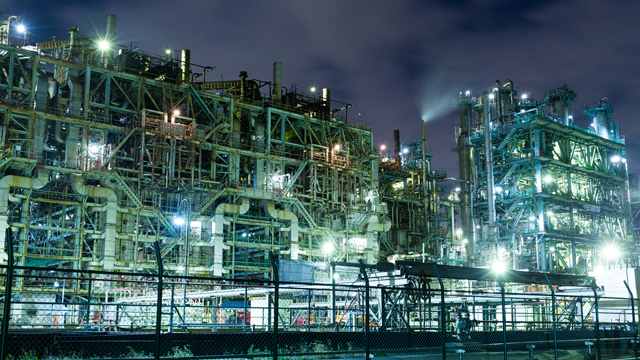Wymiana ciepła IGCC
Efficient turbine lube oil cooling is critical to the reliability of turbine-generator or turbine-driven compressor applications. To keep the lube oil at the right temperature and the right viscosity for safe and reliable operation, Alfa Laval offers an extensive range of coolers and cooling skid systems – from off-the-shelf systems to custom-engineered heat exchangers.
Optimizing power generation lube oil cooling
To keep the lube oil working at its optimal temperature, Alfa Laval offers a wide range of products and engineered solutions to cool lube oil used in turbines at power generation plants – from direct lube oil cooling systems, indirect air coolers, or complete lube oil thermal systems.
Aby utrzymać olej smarowy pracujący w optymalnej temperaturze, Alfa Laval oferuje szeroką gamę produktów i rozwiązań inżynieryjnych, które chłodzą olej smarowy stosowany w turbinach w elektrowniach - od bezpośrednich systemów chłodzenia olejów smarowych, powietrznych chłodzonych powietrzem lub pełnego oleju smarowego Systemów.
Industrial line of gasketed plate heat exchangers
Compact and modular in design, our industrial gasketed plate heat exchangers offer highly efficient heat transfer yet weigh less and take up less space than comparable units. Our global manufacturing, strong focus on compliance with standards and vast expertise enables Alfa Laval to be able to supply the optimal lube oil cooling solution in almost all situations.
Kompaktowe i modułowe konstrukcje sprawiają, że nasze przemysłowe uszczelki płytowe zapewniają bardzo wydajne przenoszenie ciepła, ale jeszcze mniej ważą i zajmują mniej miejsca niż porównywalne jednostki. Nasza globalna produkcja, silny nacisk na zgodność z normami i rozległe doświadczenie pozwala Alfa Laval na dostarczanie optymalnego rozwiązania chłodzenia olejem smarowym w niemal wszystkich sytuacjach.
Brazed heat exchangers
Alfa Laval’s brazed heat exchangers are high-efficiency oil coolers that contribute to a long and maintenance-free lifetime for lube oil systems. Alfa Laval has a range of different brazed or fusion-bound heat exchangers with off-the-shelf speeds. Quick, easy-to-use and reliable, the Alfa Laval DOC and Alfa Laval CB ranges are suitable for most lube oil systems for cooling capacities ranging from 10 kW up to 360 kW.
Wymienniki lutowane lutowane Alfa Laval są wysokowydajnymi chłodnicami oleju, które przyczyniają się do długiego i bezobsługowego okresu eksploatacji olejowych układów smarowych. Alfa Laval posiada wiele wymienników ciepła lutowanych lub wymienianych na gorąco z prędkościami obrotowymi. Szybka, łatwa w użyciu i niezawodna seria Alfa Laval DOC i Alfa Laval CB nadają się do stosowania w większości układów smarowania olejów chłodzących o mocy od 10 kW do 360 kW.
Fusion-bound heat exchangers
Highly suitable for high efficiency oil applications, Alfa Laval AlfaNova plate heat exchangers are made of 100% stainless steel to minimize the risk of corrosion.
Wymienniki ciepła Alfa Laval AlfaNova nadają się do wysokowydajnych zastosowań olejowych ze 100% stali nierdzewnej, aby zminimalizować ryzyko korozji.
Finned coil air heat exchangers
Alfa Laval finned coil air heat exchangers are used to cool the turbine lube oil in power plants. With the compact and reliable construction Alfa Laval finned coil air heat exchangers ensures optimal heat transfer of the turbine lube oil. The turbine oil is cooled directly in the air heat exchanger.
Aluminiowe wymienniki ciepła cewki Alfa Laval służą do chłodzenia oleju smarowego turbiny w elektrowniach. Dzięki kompaktowej i niezawodnej konstrukcji wymienniki ciepła Alfa Laval z powietrzem cienkowarstwowym zapewniają optymalne przenoszenie ciepła oleju smarowego turbiny. Olej turbinowy jest chłodzony bezpośrednio w powietrznym wymienniku ciepła.
Alfa Laval Packinox installations
Process overview

1. Gasifier
The coal is gasified into a synthesis gas, the “left over” (slag) is taken away for disposal. The syngas is cooled down and transferred to the gas cleaning part of the process.
2. Gas cleaning
The cool raw syngas is introduced at the bottom of the absorption tower, where it makes contact with a solvent (selexol) that travels downwards through the tower’s packing material. CO2 is absorbed by the solvent. Rest of the gas (now cleaned) goes out through the chimney.
A. Cold solvent with the CO2 goes through the Alfa Laval Packinox heat exchanger and is heated up on its way to the stripper tower.
B. Warm solvent with CO2 goes into the top of the stripper tower and then travels downwards. Steam is introduced at the bottom of the tower and travels upwards, encountering the solvent. The heat of the steam releases the CO2.
C. A mix of steam and CO2 leaves the top of the stripper. It is later cooled down to water and CO2, where the CO2 is compressed prior to storage / injection into old oil wells.
D. The clean solvent goes back in a closed loop to the absorption tower. On its way back to the absorption tower the hot clean solvent passes through the heat exchanger and is thereby heating up the solvent (with CO2) that is on its way to the stripper tower.
E. When the clean solvent heats up the cold solvent (with CO2) it is thereby cooled down. Back in the absorption tower the clean cold solvent is used to capture more CO2.
3. Gas turbine
The clean syngas is combusted in the gas turbine to generate electricity.
4. Boiler
The flue gas from the combustion is transferred to the boiler where it is heating water to generate steam.
5. Steam turbine
The steam generates additional electricity – the majority of the electricity in the IGCC plant is generated by the steam turbine.
6. Condenser
The condenser then cools down (condenses) the steam to water which is reused for cooling the raw syngas in step one of the process. The raw syngas heats up (while cooling down) the condensate which turns into steam that goes back into the boiler for further electricity generation.
7. CO2 storage
The captured and compressed CO2 is injected into old oil wells under high pressure, thereby pushing up additional oil from the well. The CO2 remains – and is thereby stored – in the geological formation.

